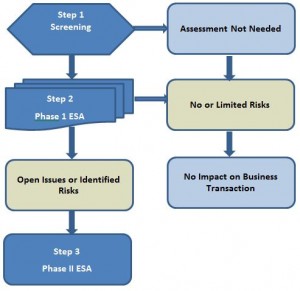Over the last twenty years, we have carried out Phase I Environmental Site Assessments (ESA) for western–based multinationals in many countries across South-East Asia and the Middle East, including sites in Thailand, Vietnam, Malaysia, Singapore, Indonesia, Myanmar, China, UAE, Kuwait, Oman, Saudi Arabia, Bahrain, Qatar, Iraq, Lebanon and Jordan.
Interestingly, we have yet to receive a single inquiry for this service from an Asian-based company. This leads to posing the obvious question:
Why do western-based multinationals carry out ESAs while Asian companies do not?
In this blog post I attempt to answer this question. In particular, I describe the purpose and history of ESA, standards for conducting an ESA, property transfer and residual environmental liability issues, and conclude by offering my thoughts on the applicability of ESAs as a tool for liability protection arising from a commercial property or investment in Asia.
What is An Environmental Site Assessment?
There is a broad array of terms and definitions related to an ESA, but for this discussion we can simplify to a few key ones:
Compliance Audit – a review of a company or a specific operating facility’s compliance to legal and regulatory requirements; this was a topic of a previous blog post.
Due Diligence – analysis of the environmental aspects of a property done in preparation for a business transaction (e.g., a corporate merger or property transfer) to establish potential business environmental risks associated with that property.
Environmental Liability – the cost to a company of cleaning up contamination caused by its activities.
Environmental Site Assessment (ESA) – a report prepared that identifies potential or existing environmental contamination and liabilities; this report can be done at varying levels of detail as so-called Phase I or Phase II ESA.
Phase I ESA – a desktop and non-intrusive site investigation to identify potential areas of concern; the most common standards in use are ASTM E1527 Standard Practice for Environmental Site Assessments: Phase I Environmental Site Assessment Process and ISO 14015 Environmental Management. Environmental Assessment of Sites and Organizations.
Phase II ESA – a more detailed level of site investigation, typically entailing soil and/or groundwater investigations of the subject property to better characterize the contaminants present and the extent of contamination at the subject property. The de facto standard for this is ASTM E1903 Standard Practice for Environmental Site Assessments: Phase II Environmental Site Assessment Process.
History of ESA
ESA as we know it today was primarily developed in the 1980s in the USA in 1980s primarily as a means for managing environmental liabilities at industrial and chemical facilities 1. It is now widely used in western countries as an important component of the merger and acquisition and property transfer process.
The ASTM standards E1527 and E1903 were first published in 1993 and 1997, respectively, while ISO 14015 was not released until 2001. Hence the wide-spread use of ASTM standards for both Phase I and II ESAs. There are many similarities between the ISO and ASTM standards but we will not get into those here other than to say that ISO 14015 is generally considered broader in scope and less prescriptive than ASTM E1527. These differences are important for lawyers and consultants tasked with carrying out the ESAs, but not so much so or the site HSE personnel.
ESA Process
The ESA process is relatively straight-forward, and carried out in a step-wise approach:

The result of the Phase I audit will be either a conclusion of (1) nil or insignificant risk with respect to potential environmental liability or (2) potential or identified significant risks that may require additional investigation to establish significance and potential environmental liability.
Okay, What Does this Mean to the HSE Manager on Site?
If the audit is being done on behalf of your corporate HSE manager and legal department or that of a prospective buyer, then you will almost be certainly asked to support the auditor during all phases of his/her work. This includes filling out various questionnaires related to the site’s history and current operations, management of chemicals, wastes, water, wastewater, emissions, etc. in addition to answering a detailed set of questions.
The ESA consultant will want to review operating permits and waste manifests, monitoring records, etc. You will need to accompany him/her on a site walkover and be prepared to inspect and photograph every nook and cranny of your facility. He/she will also inspect the adjacent properties (from the fence line) and carry out a number of other tasks such as review historical imagery of the site, talk to regulators, etc.
For relatively small/medium sized facilities, the typical Phase I ESA process takes only a day or two on site; but larger facilities can take considerably longer. A Phase II can take weeks or even months to complete depending upon the size of the site and nature of contaminants.
The report will be sent to the HQ or elsewhere for review and you may or may not be involved in the review process, depending upon the nature of the transaction and which party has requested the audit.
Environmental Liability in Asia
As noted above, the main use of a Phase I EIA is for assessing potential liability for property transfer purposes and for mergers and acquisitions.
Liability for environmental damage in most countries is an obligation for the responsible party to bear the costs of restoring the environment, the so-called “polluter-pay principle”. This obligation of remediation is usually conducted by the party responsible for the damage under an administrative or court order, in accordance with a specific clean-up project. The remediation scope may be mandated by law or left to the discretion of the competent authority, which determines specific measures using criteria such as technical feasibility, effectiveness and efficiency2.
As one might imagine, there are numerous confounding factors scenario that might be involved in any particular site may complicate the issue of who is the responsible party (e.g., prior use, releases from adjoining properties) and what constitutes environmental damage and liability. This is particularly true in most Asian countries where there are historical land use may be difficult to ascertain, there are no well-defined criteria for defining either environmental damage and there are no defined acceptable level of cleanup. As a result, the issue of defining the responsible party, the extent of environmental damage and clean-up levels is often left to the (inconsistent) findings of the authorities and professional judgement of the consultants that might be involved in the assessment
Transfer of Liability
One of the main questions I am asked by multinational corporate managers or lawyer after performing a Phase I assessment during the property transfer process is related to liability transfer from the seller to the buyer. I first of course remind them that I am not a lawyer so that they should be asking that question to their legal support team!
Nonetheless, I do offer some advice. With the exception of very few countries where liability in some cases be transferred via indemnifying the buyer (e.g., Singapore) it is best to assume nothing. That is, if you sell a property assume that the residual liability will remain with you. If you buy a property, assume that you will acquire that liability. Admittedly this seems counter-intuitive, but, in the absence of specific laws and regulations it is safer to assume the worst-case scenario.
Why Are Only Western Multinationals Concerned About Environmental Liability?
We’ve circled back to the question posed at the beginning of the blog post. There are of course specific reasons for each company, but in general the difference in the attitude to ESAs are because:
- Western companies operate in a much more litigious environment than Asian companies; so, liability protection is normal course of business for most western multinationals.
- Many western companies have suffered very serious financial and other costs associated with environmental liabilities from past business practices, so they are acutely aware of the potential costs of remediation should it be needed in the future. Most Asian companies have not faced financial setbacks as a result of poor environmental performance.
- Western companies are acutely aware that environmental regulations tend to become more stringent over time and are well aware that such changes are bound to occur in other countries in which they operate.
- Western companies typically have strong environmental management commitments to their shareholders that may require them to operate a higher standards than many Asian companies.
- Finally, western multinationals are often held to higher standards of operation by regulatory than their local counterparts.
The result is that the Phase I ESA process is a standard requirement of many multinationals but not considered important by most Asian companies.
So, Are Phase I ESAs in Asia a Waste of Time and Money?
Of course I am biased as we offer this service to our clients across Asia. But, I suggest that the Phase I ESA process is not only, not a waste of time and money but may also end up saving the client money!
How? First, assessing the potential environmental issues and liability of a property or an acquisition can give the buyer some level of confidence that they will not be inheriting a significant liability, should laws, regulations and/or enforcement change in the future. Second, if there is significant liability then this provides an opportunity for the buyer to negotiate a reduced price for the property of acquisition, so potentially can result in a significant net cost savings.
Given the increased attention being placed on environmental compliance in Asia, e.g.. China’s top court recently imposed a record-high penalty of US$26 million on six companies for discharging waste acids into two rivers, one would think that Phase 1 ESA process will soon become more prevalent across Asia. Time will tell.
And finally, if you need a Phase I ESA please feel free to contact us!
Thanks for reading. In next week’s blog post I will discuss Phase II ESA issues and in particular how to set reasonable remediation criteria when there are no specific regulations for remediation.
Thanks for reading. Keep safe. Be healthy. Respect your environment.
I hope that you will bookmark the blog, share it with your colleagues and visit the blog frequently because you find it informative and helpful. I value your feedback and suggestions for future topics.
Please enter your email in the box at the top of the post and subscribe to our blog HSE Asia – our weekly blog will be emailed directly to you.
Next Week’s Blog Topic: How Clean is Clean? Performing Phase II ESA in Countries Lacking Remediation Criteria
Photo Credits: Astronaut photo courtesy of Freerange Public Domain Archives freerange.com
- Is Your Business Compliant with HSE Regulations? Take Our Quiz to Find Out! - September 16, 2024
- Duty of Care: What it Is and What it Means to Companies Operating in the GCC? - January 28, 2024
- Free E-Book:Health, Safety, and Environment Regulatory Review – United Arab Emirates: An Overview of Federal Requirements - July 5, 2023
- M. S. Ushio 2006. To Buy or Not to Buy: Standards and practices of assessing environmental aspects of sites and companies. M. Sc. Env. Manag. And Policy. Lund University, Sweden
- OECD. 2012. Liability for Environmental Damage in Eastern Europe, Caucasus and Central Asia (EECCA): Implementation of good international practices. EAP Task Force
